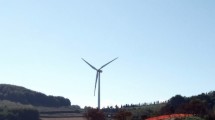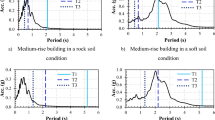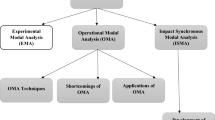Abstract
The paper discusses the application of dynamic methods for damage detection in the main cables of suspension bridges, using data continuously recorded under wind excitation through permanent monitoring systems and automated operational modal analysis.
A continuum model for predicting the vertical aeroelastic response of wind-excited damaged suspension bridges is formulated and presented at first. The model shows that, for a real sample bridge, typical variations of mean wind speed produce variations of natural frequencies, due to aeroelastic effects, that are more significant than those produced by a small damage. A possible solution to this issue, proposed in the paper, consists of removing the dependence on the excitation source by calculating frequency shifts considering frequencies, in reference and damaged states, associated to approximately the same mean wind speed. This task and the necessary estimation of frequency shifts through a statistical analysis of identified natural frequencies outline the need for a continuous dynamic monitoring.
The analytical model is finally employed for generating dynamic wind response data that are successively processed by means of an advanced automated modal identification tool. Although based on the simplifications inherently contained in the analytical model, the results show that frequency shifts caused by a relatively small damage can be accurately estimated from response data recorded under wind excitation with a reasonable number of data sets.









Similar content being viewed by others
References
Friswell MI (2007) Damage identification using inverse methods. Philos Trans R Soc Lond A 365:393–410
Reynders E, Pintelon R, De Roek G (2008) Uncertainty bounds on modal parameters obtained from stochastic subspace identification. Mech Syst Signal Process 22:948–969
Carden EP, Mita A (2011) Challenges in developing confidence intervals on modal parameters estimated for large civil infrastructure with stochastic subspace identification. Struct Control Health Monit 18:53–78
Yuan Y, Liu H (2012) An iterative updating method for undamped structural systems. Meccanica 47:699–706
Perera R, Fang SE, Ruiz A (2010) Application of particle swarm optimization and genetic algorithms to multiobjective damage identification inverse problems with modelling errors. Meccanica 45:723–734
Breccolotti M, Franceschini G, Materazzi AL (2004) Sensitivity of dynamic methods for damage detection in structural concrete bridges. Shock Vib 11(3–4):383–394
Peeters B, De Roeck G (2001) One-year monitoring of the Z24-bridge: environmental effects versus damage events. Earthq Eng Struct Dyn 30:149–171
Li H, Li S, Ou J, Li H (2010) Modal identification of bridges under varying environmental conditions: temperature and wind effects. Struct Control Health Monit 17:495–512
Gentile C, Saisi A (2010) Dynamic assessment of the iron bridge at Paderno d’Adda (1889). Adv Mater Res 133–134:709–714
Gentile C, Saisi A (2011) Ambient vibration testing and condition assessment of the Paderno iron arch bridge (1889). Constr Build Mater 25(9):3709–3720
Laermann KH (2010) Assessment of structural integrity and durability a task of experimental mechanics. Meccanica 45:167–174
Petrini F, Bontempi F (2011) Estimation of fatigue life for long span suspension bridge hangers under wind action and train transit. Struct Infrastruct Eng 7(7–8):491–507
Betti R, West AC, Vermaas G, Cao Y (2005) Corrosion and embrittlement in high-strength wires of suspension bridge cables. J Bridge Eng 10(2):151–162
Cremona C (2003) A short note on cable fatigue. In: Proc. 5th international symposium on cable dynamics
Breccolotti M, Gusella V, Materazzi AL (2007) Active displacement control of a wind-exposed mast. Struct Control Health Monit 14(4):556–575
Ubertini F (2008) Active feedback control for cable vibrations. Smart Struct Syst 4(4):407–428
Faravelli L, Fuggini C, Ubertini F (2010) Toward a hybrid control solution for cable dynamics: theoretical prediction and experimental validation. Struct Control Health Monit 17(4):386–403
Simiu E, Scanlan RH (1996) Wind effects on structures, 3rd edn. Wiley, New York
Scanlan RH (2000) Motion-related body-force functions in two-dimensional low-speed flow. J Fluids Struct 14:49–63
Domaneschi M, Limongelli MP, Martinelli L (2011) Wind driven damage detection on a suspension bridge. In: Proceedings of the EVACES 2011 conference, Varenna, 3–5 October 2011
Materazzi AL, Ubertini F (2011) Eigenproperties of suspension bridges with damage. J Sound Vib 330:6420–6434
Lepidi M, Gattulli V, Vestroni F (2007) Static and dynamic response of elastic suspended cables with damage. Solids Struct 44:8194–8212
Irvine HM, Caughey TK (1974) The linear theory of free vibrations of suspended cables. Proc R Soc Lond 341:299–315
Irvine HM (1981) Cable structures. MIT Press, Cambridge
Luco JE, Turmo J (2010) Linear vertical vibrations of suspension bridges: a review of continuum models and some new results. Soil Dyn Earthq Eng 30:769–781
Carpineto N, Lacarbonara W, Vestroni F (2010) Mitigation of pedestrian-induced vibrations in suspension footbridges via multiple tuned mass dampers. J Vib Control 16(5):749–776
Carassale L, Solari G (2002) Wind modes for structural dynamics: a continuous approach. Probab Eng Mech 17:157–166
Gattulli V, Martinelli L, Perotti F, Vestroni F (2007) Dynamics of suspended cables under turbulence loading: reduced models of wind field and mechanical system. J Wind Eng Ind Aerodyn 95:183–207
Salvatori L, Spinelli P (2006) Effects of structural nonlinearity and along-span wind coherence on suspension bridge aerodynamics: some numerical simulation results. J Wind Eng Ind Aerodyn 94:415–430
Ubertini F (2010) Prevention of suspension bridge flutter using multiple tuned mass dampers. Wind Struct 13(3):235–256
Hong AL, Ubertini F, Betti R (2011) Wind analysis of a suspension bridge: identification and finite-element model simulation. ASCE J Struct Eng 137(1):133–142
Ubertini F, Gentile C, Materazzi AL (2013) Automated modal identification in operational conditions and its application to bridges. Eng Struct 46:264–278
Gusella V, Materazzi AL (1998) Non-Gaussian response of MDOF wind-exposed structures: analysis by bicorrelation function and bispectrum. Meccanica 33(3):299–307
Jones NP, Scanlan RH (2001) Theory and full-bridge modeling of wind response of cable-supported bridges. J Bridge Eng 6(6):365–375
Caracoglia L (2008) Influence of uncertainty in selected aerodynamic and structural parameters on the buffeting response of long-span bridges. J Wind Eng Ind Aerodyn 96:327344
The Mathworks Inc (2010) Matlab and Simulink, Natickm
SVS (2010) ARTeMIS Extractor 2010 release 5.0. http://www.svibs.com
Van Overschee P, De Moor B (1996) Subspace identification for linear systems: theory, implementation, application. Kluwer, Dordrecht
Cantieni R (2005) Experimental methods used in system identification of civil engineering structures. In: Proceedings of the first international operational modal analysis conference (IOMAC’05)
Author information
Authors and Affiliations
Corresponding author
Appendices
Appendix A: Structural eigenmodes
The eigenmodes derived in [21] are here recalled for the sake of completeness.
In the case of antisymmetric motions, the eigenfunctions and eigenfrequencies are
where i=1,2,3,… is the modal order and C i is a set of amplitude coefficients. In the case of symmetric motions the eigenfunctions are, instead, given by the following equation:

where \(\overline{h}_{i}=\int_{0}^{1}\phi_{i}(\overline{x})\mathrm{d}\overline {x}\), while \(\alpha_{i}^{2}\) and \(\beta_{i}^{2}\) are defined as
The unknown \(\overline{\omega}_{i}\) are solutions of the following characteristic equation:

whose calculation requires a numerical procedure.
Appendix B: Generation of buffeting loads
A generation formula for the modal components of the buffeting loads, vector  in (40), is here presented using a classical model for the turbulent wind field.
in (40), is here presented using a classical model for the turbulent wind field.
Let us assume that \(\overline{u}(\overline{x},\overline{t})\) and \(\overline{w}(\overline{x},\overline{t})\) are realizations of zero mean Gaussian random processes and that the cross power spectral density function of u (analogous expressions can be written for w) is given by
where \(\overline{S}_{u}(\omega)\) is the power spectral density of the random process for x=x′ and \(\operatorname{Coh}_{u}\) is the so-called coherence function. The following analytical expressions for \(\overline{S}_{u}(\omega)\) and \(\overline{S}_{w}(\omega )\) can be used [27]:


where \(\sigma^{2}_{u}\) and \(\sigma^{2}_{w}\) are the variances, while L u and L w are the integral length scales, of u and w, respectively. The coherence function assumes the classic exponential form
where C ux is a positive coefficient whose value depends upon the terrain conditions (a similar expression can be written for \(\operatorname{Coh}_{w}\), with exponential coefficient C wx ).
By subdividing the frequency interval \([0\ \widetilde{\omega}]\) into N ω steps of amplitude Δω, expressing frequencies in non-dimensional form (11), and posing \(\overline{\omega}_{j}=j\varDelta \overline{\omega}\), realizations of the turbulent wind velocities can be obtained by means of the following Monte Carlo formula [27]:


where


\(R_{uj}^{r}\), \(I_{uj}^{r}\), \(R_{wj}^{r}\) and \(I_{wj}^{r}\) being zero-mean normal random numbers with variances equal to 1/2.
In (65), (66) γ ur and θ ur are the r-th eigenvalue and eigenfunction of the stochastic process \(u(\overline{x},\overline{t})\), while γ wr and θ wr are the same quantities for the vertical component \(w(\overline {x},\overline{t})\). Using (61), (64), they can be analytically expressed as follows [27] (similar expressions hold for w):


where α u (ω)=|ω|C ux /(2πU) and the parameters μ k are solutions of the following non-linear equation:
Substituting (65), (66) into (28), (29) yields


where the sum has been truncated to consider the lowest n w wind modes. In (72), (73) the following quantities assume the meaning of cross-modal participation coefficients:


Substituting (72), (73) in (25) yields the expression of the modal buffeting load components appearing in vector  in (40).
in (40).
Appendix C: Model dimension reduction
A convergence analysis of the solution of (40) with respect to the number of retained structural and wind modes (n s and n w , respectively) is carried out for the NCB assuming a damage intensity factor η=0.05 (5 % reduction of the whole cable section). Data are generated by the analytical model with a total length of 1-hour which, in non-dimensional time, corresponds to \(\overline{t}=450\).
Figure 10(a) shows window plots of the vertical non-dimensional displacement at quarter span for a typical wind realization and considering increasing numbers of wind modes between 1 and 20 and 20 structural modes. Figure 10(b) shows a plot of the normalized relative error with respect to the solution obtained by considering 20 wind modes. The error, in Fig. 10(b), is calculated as follows:
where T is the total duration of the response (450 in non-dimensional time corresponding to 1 hour in dimensional time), \(\overline{v}_{n_{w}}\) is the solution obtained by retaining n w wind modes and n w,max =20. The results presented in Fig. 10(b), normalized with respect to the maximum value of \(\epsilon_{n_{w}}\) (corresponding to n w =1), demonstrate that the solution essentially converges with 10 wind modes. Figure 10(c) shows plots of the power spectral density (PSD) of the quarter-span displacement normalized by multiplication by the frequency and by division by its maximum value. This plot shows that the first wind mode excites the first symmetric structural mode (peak 1S) but not the first antisymmetric one (peak 1A) that, instead, is activated by the second wind mode. For this reason, in Fig. 10(a), the vertical quarter-span displacement is much smaller for n w =1 than for n w =2. Figure 10(d) shows a plot of the envelope of the maximum vertical non-dimensional displacements along the span of the bridge. It shows that the maximum displacements are essentially well predicted already with 4 wind modes.
Convergence of the analytical response with the number of retained wind modes: vertical quarter span displacement (a); normalized relative error convergence (b); quarter span normalized displacement power spectrum (norm. PSD) (c); envelope of maximum displacements along the longitudinal axis of the bridge (d)
Figure 11(a) shows plots of the vertical non-dimensional displacement at quarter span for a typical wind realization, considering increasing numbers of structural modes between 1 and 20 and considering 20 wind modes. Figure 11(b) shows a plot of the normalized relative error with respect to the solution obtained by considering 20 structural modes. The error is calculated as in (76) with n s instead of n w . The results presented in Fig. 11(b) show that convergence of the solution is essentially achieved by considering 10 structural modes. Figure 11(c) shows plots of the PSD of the quarter-span displacement normalized as in Fig. 11(c). Figure 11(d) shows a plot of the envelope of the maximum vertical non-dimensional displacements along the span of the bridge. It shows that the maximum displacements are essentially well predicted already with 2 structural modes.
Convergence of the analytical response with the number of retained structural modes: vertical quarter span displacement (a); normalized relative error convergence (b); quarter span normalized displacement power spectrum (norm. PSD) (c); envelope of maximum displacements along the longitudinal axis of the bridge (d)
Rights and permissions
About this article
Cite this article
Ubertini, F. On damage detection by continuous dynamic monitoring in wind-excited suspension bridges. Meccanica 48, 1031–1051 (2013). https://doi.org/10.1007/s11012-012-9650-2
Received:
Accepted:
Published:
Issue Date:
DOI: https://doi.org/10.1007/s11012-012-9650-2






